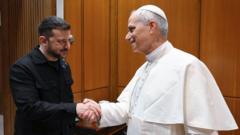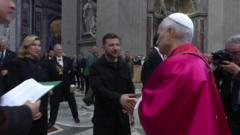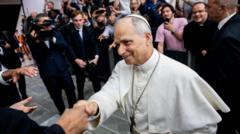**As cardinals vote behind closed doors, the chimney atop the Sistine Chapel plays a critical role in conveying the outcome to the awaiting public.**
**Papal Conclave Traditions: The Signal of Smoke**

**Papal Conclave Traditions: The Signal of Smoke**
**The intricate process of signaling a new pope through colored smoke captivates the world during papal conclaves.**
Once the cardinals gather in the Sistine Chapel for the highly-anticipated papal conclave, the world focuses on a small chimney protruding from the chapel. This chimney serves as the communicator, releasing either white or black smoke visible from the bustling St. Peter’s Square. White smoke indicates the election of a new pope, while black smoke signifies that no decision has been reached.
This tradition, rooted in history since the 19th century, has a fascinating evolution. According to Frederic J. Baumgartner in “Behind Locked Doors,” the practice of using smoke as a signal dates back to at least 1823. Previous conclaves involved burning the cardinals' ballots, yet there is little documentation that this smoke was meant to inform the public.
The signaling process involves burning votes and notes in a cast-iron stove after each round of voting. Each conclave typically starts with a single round on the first day, followed by several rounds over the ensuing days. Traditionally, ballots were burned after each two rounds of voting unless a new pope emerged.
Historically, the technique for creating the smoke color has evolved. In earlier centuries, wet straw was utilized to produce white smoke, but this method often led to erroneous signals. Notably, during the 1958 conclave, white smoke falsely appeared on two occasions before a pope was finally selected, creating a whirlwind of confusion.
As technology continues to evolve, the methods employed during these iconic ceremonies may change, but the suspense and tradition surrounding the signaling of the pope through smoke remain timeless, marking a momentous occasion in the lives of millions worldwide.
This tradition, rooted in history since the 19th century, has a fascinating evolution. According to Frederic J. Baumgartner in “Behind Locked Doors,” the practice of using smoke as a signal dates back to at least 1823. Previous conclaves involved burning the cardinals' ballots, yet there is little documentation that this smoke was meant to inform the public.
The signaling process involves burning votes and notes in a cast-iron stove after each round of voting. Each conclave typically starts with a single round on the first day, followed by several rounds over the ensuing days. Traditionally, ballots were burned after each two rounds of voting unless a new pope emerged.
Historically, the technique for creating the smoke color has evolved. In earlier centuries, wet straw was utilized to produce white smoke, but this method often led to erroneous signals. Notably, during the 1958 conclave, white smoke falsely appeared on two occasions before a pope was finally selected, creating a whirlwind of confusion.
As technology continues to evolve, the methods employed during these iconic ceremonies may change, but the suspense and tradition surrounding the signaling of the pope through smoke remain timeless, marking a momentous occasion in the lives of millions worldwide.




















